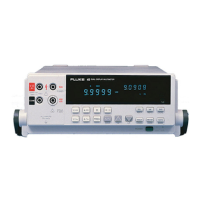45
Service Manual
8-12
8-20. Failure to Receive Multiple Character Commands
Monitor the interrupt signal from A5U6-10 during attempts to communicate with the
meter. Each byte received with the ATN signal (A5U6-31) high should cause the
interrupt signal to go low. Follow the interrupt signal through A5U4, and verify that it
arrives at A5J3 properly. If the interrupt is not detected by A1U6, it will remain low
indefinitely. A5U6-10 will only go high when both the interrupt is detected and the
received byte is removed from A5U6 by A1U6.
8-21. Failure to Transmit Query Responses
Check that TE (A5U6-24) goes high when the interface is addressed to talk. This signal
must go high to allow the bus interface transceivers to change the direction of DIO1
through DIO8, EOI, DAV, NRFD, and NDAC. Verify that each of these signals passes
through A5U7 and A5U8 properly.
8-22. Failure to Generate an End or Identify (EOI)
When the IEEE-488 Interface Option sends the Line Feed termination character with a
message, the EOI signal should also be set true. When EOI is true, A5U6-30 should go
low. Follow this signal from A5J1 through A5U8 to A5U6.
8-23. Failure to Generate a Service Request (SRQ)
When a Service Request is being generated, A5U6-32 should be low. Follow this signal
through A5U8 to connector A5J1. When a Serial Poll (SPL) is performed by the IEEE-
488 bus controller, A5U6-32 will go high again.
Note
If the meter is in the remote state without front panel lockout (i.e., REMS),
a service request can be sent from the front panel by pressing [UPB].
8-24. Schematic Diagram
The schematic diagram for the IEEE-488 Interface Option is included in Chapter 9 of
this manual.
8-25. List of Replaceable Parts
Figures 8-4 and 8-5 provide illustration for the parts lists in Tables 8-3 and 8-4,
respectively. Refer to Chapter 6 for parts ordering information.

